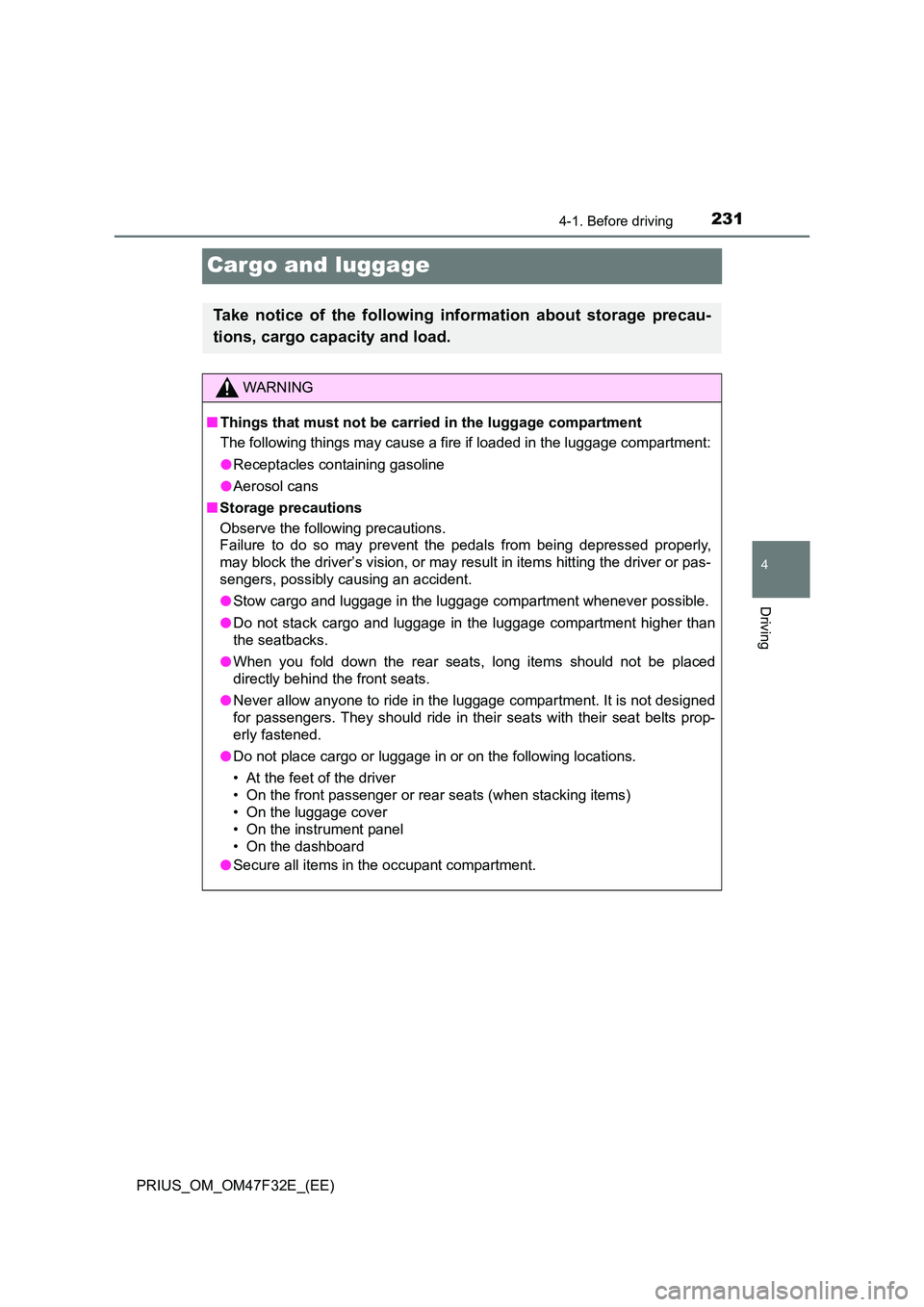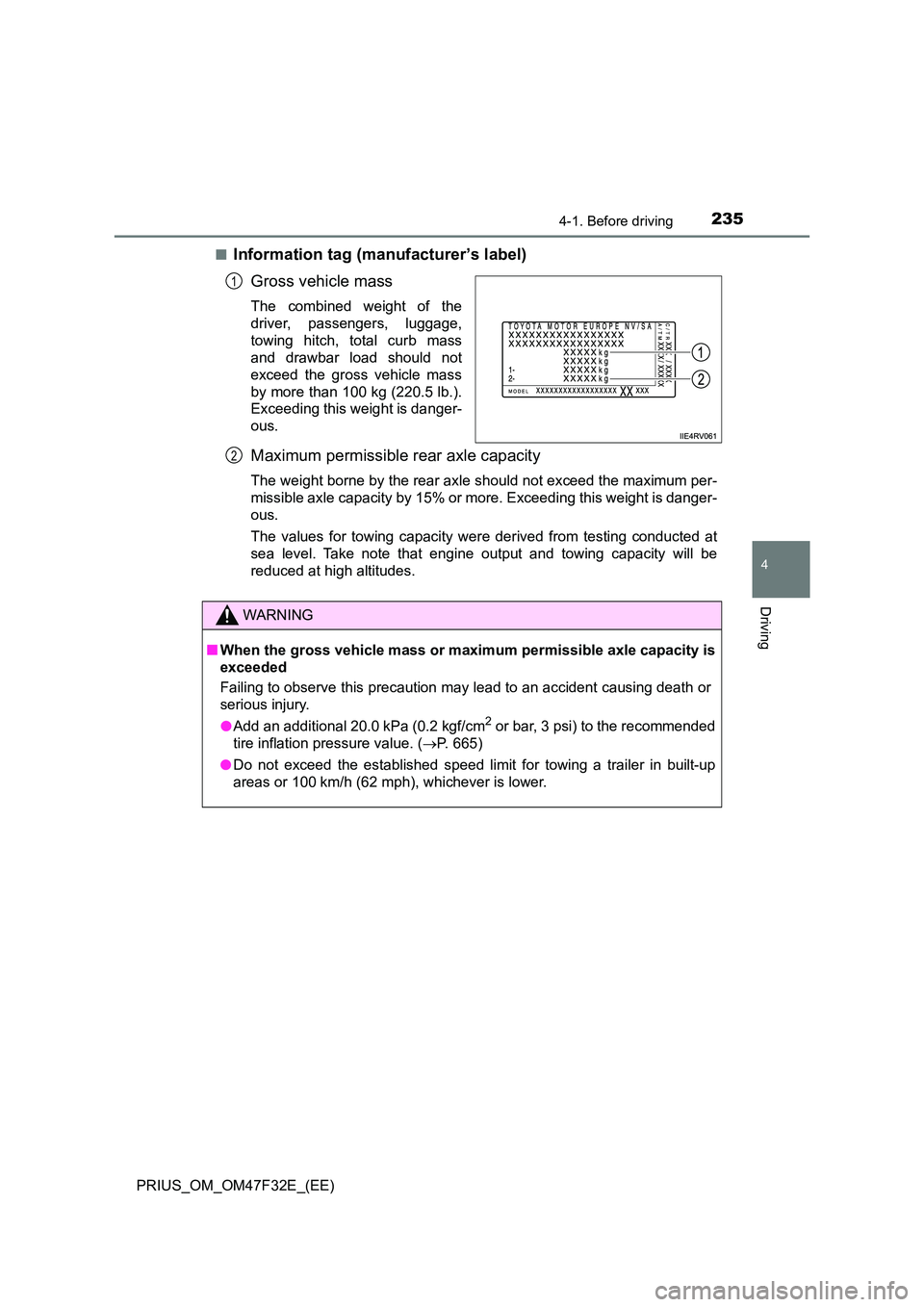Page 233 of 770

231
4
4-1. Before driving
Driving
PRIUS_OM_OM47F32E_(EE)
Cargo and luggage
Take notice of the following information about storage precau-
tions, cargo capacity and load.
WARNING
■ Things that must not be carried in the luggage compartment
The following things may cause a fire if loaded in the luggage compartment:
● Receptacles containing gasoline
● Aerosol cans
■ Storage precautions
Observe the following precautions.
Failure to do so may prevent t he pedals from being depressed properly,
may block the driver’s vision, or may re sult in items hitting the driver or pas-
sengers, possibly causing an accident.
● Stow cargo and luggage in the luggage compartment whenever possible.
● Do not stack cargo and luggage in the luggage compartment higher than
the seatbacks.
● When you fold down the rear seats, long items should not be placed
directly behind the front seats.
● Never allow anyone to ride in the luggage compartment. It is not designed
for passengers. They should ride in their seats with their seat belts prop-
erly fastened.
● Do not place cargo or luggage in or on the following locations.
• At the feet of the driver
• On the front passenger or rear seats (when stacking items)
• On the luggage cover
• On the instrument panel
• On the dashboard
● Secure all items in the occupant compartment.
Page 236 of 770

2344-1. Before driving
PRIUS_OM_OM47F32E_(EE)
◆Weight limits
Check the allowable towing capacity, GVM (Gross Vehicle Mass),
MPAC (Maximum Permissible Axle Capacity), and permissible
drawbar load before towing. (P. 654)
◆Towing hitch/bracket
Toyota recommends the use of the Toyota hitch/bracket for your
vehicle. Other products of a suitable nature and comparable quality
may also be used.
For vehicles where the towing device blocks any of the lights or
license plate, the following shall be observed:
●Do not use towing devices that cannot be easily removed or
repositioned.
●Towing devices must be removed or repositioned when not in
use.
Please consult at any authorized dealer or repairer, or another duly
qualified and equipped professional when installing trailer lights, as
incorrect installation may cause damage to the vehicle’s lights. Please
take care to comply with your state’s laws when installing trailer lights.
■Total trailer weight and permissible drawbar load
Total trailer weight
Weight of the trailer itself plus
the trailer load should be within
the maximum towing capacity.
Exceeding this weight is danger-
ous. (P. 654)
When towing a trailer, use a fric-
tion coupler or friction stabilizer
(sway control device).
Permissible drawbar load
Allocate the trailer load so that the drawbar load is greater than 25 kg
(55.1 lb.) or 4% of the towing capacity. Do not let the drawbar load
exceed the indicated weight. (P. 654)
Connecting trailer lights
Important points regarding trailer loads
1
2
Page 237 of 770

2354-1. Before driving
4
Driving
PRIUS_OM_OM47F32E_(EE)
■Information tag (manufacturer’s label)
Gross vehicle mass
The combined weight of the
driver, passengers, luggage,
towing hitch, total curb mass
and drawbar load should not
exceed the gross vehicle mass
by more than 100 kg (220.5 lb.).
Exceeding this weight is danger-
ous.
Maximum permissible rear axle capacity
The weight borne by the rear axle should not exceed the maximum per-
missible axle capacity by 15% or more. Exceeding this weight is danger-
ous.
The values for towing capacity were derived from testing conducted at
sea level. Take note that engine output and towing capacity will be
reduced at high altitudes.
1
2
WARNING
■ When the gross vehicle mass or maximum permissible axle capacity is
exceeded
Failing to observe this precaution may lead to an accident causing death or
serious injury.
● Add an additional 20.0 kPa (0.2 kgf/cm2 or bar, 3 psi) to the recommended
tire inflation pressure value. ( P. 665)
● Do not exceed the established speed limit for towing a trailer in built-up
areas or 100 km/h (62 mph), whichever is lower.
Page 450 of 770
4484-5. Using the driving support systems
PRIUS_OM_OM47F32E_(EE)
WARNING
■When the TRC/VSC systems are turned off
Be especially careful and drive at a speed appropriate to the road condi-
tions. As these are the systems to help ensure vehicle stability and driving
force, do not turn the TRC/VSC systems off unless necessary.
■ Replacing tires
Make sure that all tires are of the specified size, brand, tread pattern and
total load capacity. In addition, make sure that the tires are inflated to the
recommended tire inflation pressure level.
The ABS, TRC and VSC systems will not function correctly if different tires
are installed on the vehicle.
Contact any authorized Toyota retailer or Toyota authorized repairer, or any
reliable repairer for further information when replacing tires or wheels.
■ Handling of tires and the suspension
Using tires with any kind of problem or modifying the suspension will affect
the driving assist systems, and may cause a system to malfunction.
Page 541 of 770

5396-3. Do-it-yourself maintenance
PRIUS_OM_OM47F32E_(EE)
6
Maintenance and care
Wheels
When replacing wheels, care should be taken to ensure that they are
equivalent to those removed in load capacity, diameter, rim width and
inset
*.
Replacement wheels are available at any authorized Toyota retailer or
Toyota authorized repairer, or any reliable repairer.
*: Conventionally referred to as “offset”.
Toyota does not recommend using the following:
●Wheels of different sizes or types
●Used wheels
●Bent wheels that have been straightened
●Use only Toyota wheel nuts and wrenches designed for use with
your aluminum wheels.
●When rotating, repairing or changing your tires, check that the
wheel nuts are still tight after driving 1600 km (1000 miles).
●Be careful not to damage the aluminum wheels when using tire
chains.
●Use only Toyota genuine balance weights or equivalent and a plas-
tic or rubber hammer when balancing your wheels.
If a wheel is bent, cracked or heavily corroded, it should be
replaced. Otherwise, the tire may separate from the wheel or
cause a loss of handling control.
Wheel selection
Aluminum wheel precautions
Page 656 of 770
6548-1. Specifications
PRIUS_OM_OM47F32E_(EE)
Maintenance data (fuel, oil level, etc.)
*1: Unladen vehicle
*2: Vehicles with 195/65R15 tires
*3: Vehicles with 215/45R17 tires
*4: Vehicles that can tow a trailer. (P. 233)
Dimensions and weights
Overall length4575 mm (180.1 in.)
Overall width1760 mm (69.3 in.)
Overall height*1
2WD
models
Without raised
vehicle height1470 mm (57.9 in.)
With raised vehi-
cle height1490 mm (58.7 in.)
AWD models1475 mm (58.1 in.)
Wheelbase2700 mm (106.3 in.)
Tread*1
Front1530 mm (60.2 in.)*2
1510 mm (59.4 in.)*3
Rear
Without raised
vehicle height1540 mm (60.6 in.)*2
1520 mm (59.8 in.)*3
With raised vehi-
cle height1530 mm (60.2 in.)*2
1510 mm (59.4 in.)*3
Gross vehicle
mass2WD models1790 kg (3946 lb.)
AWD models1845 kg (4068 lb.)
Maximum per-
missible axle
capacityFront1020 kg (2249 lb.)
Rear975 kg (2150 lb.)
Drawbar load*460kg (132 lb.)
Towing capac-
ity
*4
Without brake725 kg (1598 lb.)With brake